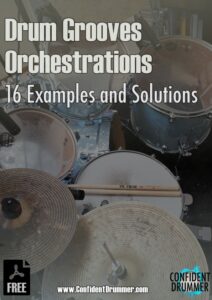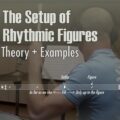It’s interesting to realize that the drum set, as we know it, is only a little over 100 years old.
Our musical instrument is actually obtained by combining many different instruments, like drums, cymbals, percussions and electronics, and is constantly evolving.
We are used to think of it as ‘the drum set’, and we often forget what the name itself is saying: that it’s indeed a set of drums.
If we take into account that we have this multitude of elements, and we can totally customize each detail (size, positions, heads and tuning, hardware, electronics, sounds, special effect cymbals and percussions, and so on) it’s clear that the possibilities are endless.
This is why when I’m at my drum kit I always feel like I’m playing a small orchestra, sometimes tiny and sometimes large, but still complete nonetheless.
This way of seeing things is really important because it entails that we are free to experiment, move notes and phrases on different surfaces, and thus create new versions of whatever we are playing.
This approach is called ‘orchestration’, and it’s amazing what it allows us to achieve.
The most spectacular aspect is the diversity allowed by the same exact beat when played on different surfaces. We can therefore definitely include orchestrations in our parameter list, as explained in the cornerstone article ‘How to Develop Musicality – Focusing on the How of Drumming with Parameters‘, and even consider it one of the most important ones.
As a matter of fact I find learning how to use what we already know in original and creative ways extremely smart and effective, as opposed to continuously adding new materials and thinking that that’s the only way to expand our vocabulary.
Again, I stress the importance of going deep, instead of focusing just on width, in order to develop and realize our musical potential.
So, in this case we choose a couple of rhythms and we study a page of orchestration examples each. We are going to use first a shuffle beat and then a linear groove, which are among the most suitable for this kind of applications.
You can download the PDF with the full lesson and all exercises and transcriptions here:
You can also click on each example in the PDF to access the related demonstration, or watch the full 5 minute YouTube video by clicking HERE.
Of course these are pretty simple examples, and the idea is to experiment not only with the proposed exercises, but also – and mostly – with our own solutions, to further personalize them.
A good starting point could be to pick some of the beats from ‘The Ultimate Drum Grooves Collection – 80 Contemporary Beats‘ and practice applying the same concepts until we can use them effortlessly.
When studying orchestrations it pretty soon becomes clear that arranging the same patterns in different ways is often more challenging than it seems. It takes a lot of skill to manage the different rebound of each surface and to stay balanced while moving around the kit.
Which is precisely why learning how to deal with all these aspects is going to be very beneficial and will help us play the drums in a completely relaxed and masterful manner.
Practicing orchestrations is therefore useful in many ways, as this is one of the parameters that not only increase our musicality but also let us improve our overall drumming technique.
As a matter of fact, we can make the most of these techniques by trying combining them with some other parameters, such as those explored in the dedicated articles and guides:
– Speed: ‘One Groove – Eight Tempos – 40 to 180 BPM‘.
– Dynamics: ‘Increasing Dynamic Control – Snare Drum & Grooves‘.
– Permutations: ‘Advanced Drum Permutations – 1 Groove – 1 Fill – 29 Variations‘.
– Swing Level: ‘Swing Level Control – In Between, Narrow, Hard – Exercises, Grooves, Examples‘.
Related resources:
‘Groove Workout & Tools’ – Altitude Drumming – Volume 7
‘Groove Mastery & Formulas’ – Altitude Drumming – Volume 8




















